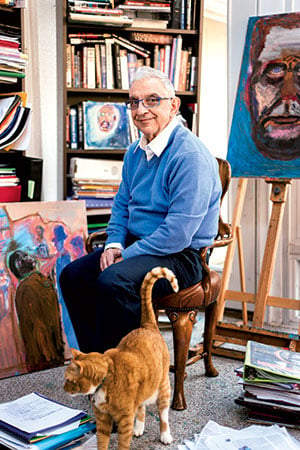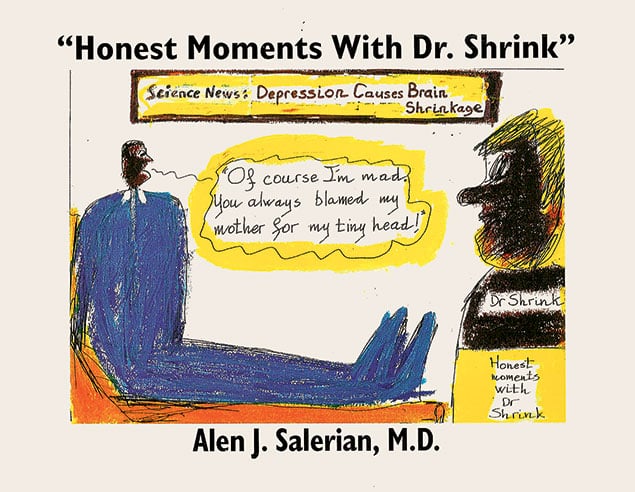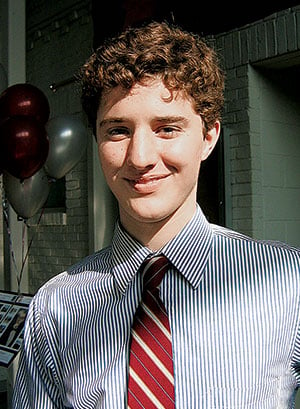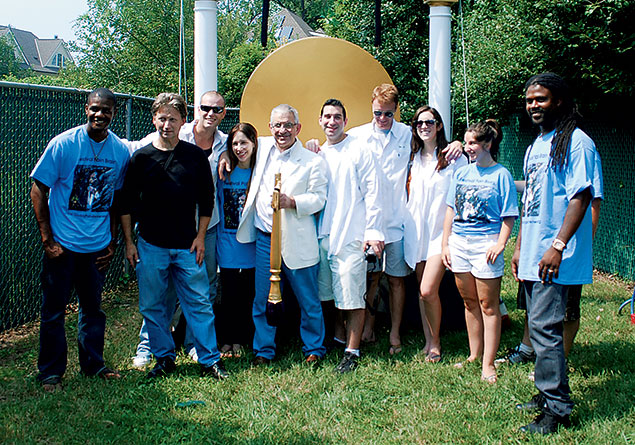About five years ago, C. Ray Foster, the sheriff of Buchanan
County, Virginia, noticed the name of an unfamiliar doctor on the pill
bottles turning up at drug busts, overdoses, and DUIs. OxyContin and other
narcotic painkillers feed an epidemic of crime and addiction as insidious
in this Appalachian outpost as the kudzu astride the Levisa Fork River.
But this prescriber’s name—Alen Salerian—was an enigma.
The man wasn’t a pain specialist but a psychiatrist, a doctor
trained to treat mental illness. And his office was 400 miles north, in
one of Washington’s wealthiest neighborhoods.
“I came out of there with 450 roxy 30s, 450 methadone 10s,
Adderall and Xanax,” someone calling himself “Crazy” wrote online about
his first visit to Salerian, the popular subject of nearly 500 posts in a
Buchanan County web forum. “My sister went the same day and got the same
thing. . . . At one time 5 of us rode together and he made our
appointments back to back . . . . I don’t know how in the world we made it
home we would be so messed up.”
The question Foster kept asking himself was why people in his
impoverished county were driving up to eight hours each way—sometimes in
caravans and carpools—to see a psychiatrist, one who didn’t even take
insurance.
Salerian’s colleagues back in Washington would have been just
as bewildered. Salerian, now 66, was once chief psychiatrist to the FBI’s
employee-assistance program, traveling the world to minister to troubled
agents. He taught at George Washington University, published in medical
journals, wrote op-eds for the Washington Post.
His private practice, steps from the Neiman Marcus in DC’s
Friendship Heights, was a world away from the troubles of Buchanan
(pronounced “buck-cannon”) County, a once-booming coalfield at Virginia’s
border with Kentucky and West Virginia that’s now one of the poorest and
most isolated places in the state.
To get there from Washington this past September, I drove for
hours down interstates 66 and 81, up through tunnels bored into mountains,
and over the Trail of the Lonesome Pine. Finally, the road tucked into
valleys so vertiginous that for much of the day the hills were shrouded in
shadow.
Sheriff Foster—a wry lawman with a silver mustache and a
reputation for candor—was at his desk, picking at a breakfast of biscuits
and gravy in a Styrofoam clamshell, when I entered. “I’m an old fat man,”
he quipped when asked his age.
But when I mentioned Salerian, Foster grew serious, turning off
the air conditioner and dialing up his hearing aid. Buchanan County
residents die of prescription-painkiller overdoses at more than five times
the statewide rate, and Foster held the psychiatrist at least partly
responsible. His pills had shown up at drug scenes across the county and
in the homes of families so lost to addiction that the state had to take
custody of children.
“I’ve never met him, but I’ve met a lot of his work,” Foster
said. “His clientele has become my clientele”—by which he meant denizens
of the county lockup.
The giant doses Salerian was prescribing to young, seemingly
healthy people in the county where Foster had grown up didn’t make sense.
“Why would a 20-year-old feller take five Oxys a day?” he asked. “Why
would you prescribe that to a 20-year-old that has not got cancer, has not
got no fatal disease, has got no chronic pain?”
• • •
A visitor to Alen Salerian’s office in the 1980s and ’90s would
have encountered one of the most glittering waiting rooms in Washington.
Middle Eastern royals, Hollywood actors, and heiresses were all under his
care, as were a general and a senator turned presidential candidate. Many
patients felt he was the first doctor to really understand their
suffering: “the one person I trusted,” local author Gail Griffith said in
a memoir.
Though just five-foot-seven, Salerian had a way of filling a
room. He was garrulous, with an exotic accent and boisterous charm, and he
loved the limelight. He had wrangled a gig as an on-air commentator for
Channel 9, Washington’s CBS affiliate, and was sought out for his
expertise by TV programs such as 48 Hours.

once held a glamorous post with the US government, counseling FBI
agents. Today the government alleges that Salerian (shown at home in
Bethesda) is a major supplier of pills to drug addicts and dealers in
southwestern Virginia. Photograph by Andrew Propp.
It was a remarkable ascent for a man who’d landed in the US
from Istanbul in 1971 with no connections beyond a letter admitting him to
a medical internship. Salerian’s father, a successful engineer, and
mother, a noted painter, had sent him and his identical-twin brother to
America because they saw no future for Christian Armenians like them in
Turkey. Alen’s brother, Nansen Saleri, now a Houston oil executive, calls
himself the ace student and “conformist one.” Alen was more like his
mother, a social butterfly with artistic impulses who sometimes skipped
school to be with friends.
No one was surprised when he declared an interest in
psychiatry. “He wanted to be around people,” Nansen says; among all the
medical specialties, “it would allow him more of an emotional relationship
with patients.”
Salerian’s supervisors at George Washington University, where
he completed his psychiatry training, named Salerian chief resident and
hired him as an assistant clinical professor right after his training
ended in 1976. He was no less a hit at Metropolitan Psychiatric Group, one
of the nation’s largest group mental-health practices. Salerian drew so
much business to its DC and Rockville offices that the group made him
partner after just two years.
Soon after a Pennsylvania company acquired the group in 1994,
Salerian took a $1.5-million payout and started his own practice on the
ground floor of the Psychiatric Institute of Washington, a Wisconsin
Avenue hospital that eventually named him associate medical
director.
It was a heady time. Pharmaceutical companies were so taken by
the doctor’s social dexterity that they paid him tens of thousands of
dollars a year to host dinners introducing colleagues to new drugs. He’d
also landed a glamorous five-year contract with the FBI’s
employee-assistance program, which wanted him to find help for agents
wrestling with alcoholism, family strife, and other personal
issues.
Salerian, a married father of four, had always liked difficult
cases: patients whose depression responded to none of the usual
treatments, manic-depressives who’d sooner live on the streets than take
their meds. At the FBI, he cracked his toughest case yet: getting hardened
agents to confide in a shrink.
Chuck McCormick, a former FBI agent who led the assistance
program in the 1990s, says he could call day or night and Salerian would
get on the next plane to anywhere in the world—domestic FBI offices,
overseas embassies. “We saved lives, salvaged careers,” McCormick says.
“We kept families together. We prevented divorces. He was a
godsend.”
A few years into the contract, however, Salerian had a
falling-out with the agency over what he construed as a supervisor’s
racist remark about his olive-toned skin. “I used every F-word,” Salerian
recalls of his response. McCormick says he remembers no such incident. All
the same, the bureau decided to shift its program in-house after
Salerian’s contract was up in 1997—a parting that would come to haunt the
FBI and the doctor both.
• • •
In February 2001, a veteran FBI spy catcher, Robert Hanssen,
was arrested in the gravest security breach in the bureau’s history: The
mild-seeming Virginia man, it turned out, was a double agent who had been
selling US secrets to the Russians for more than two decades.
In his former employer’s humiliation, Salerian glimpsed
opportunity. He had been trying for years to write opinion pieces for
major newspapers, with scant success (despite the help of publicists).
Three weeks after Hanssen’s arrest, Salerian got his big break: The
Post published his long op-ed flogging the FBI for not subjecting
agents to routine mental-health checks.
The piece read like a John Grisham thriller, with Salerian as
its dashing lead, a troubleshooter who’d saved the agency from untold
numbers of overstressed G-men who might well have become other
Hanssens.
He made no mention of his falling-out with the FBI. Nor did he
disclose that he was just then auditioning for a starring role with
Hanssen’s defense team.
Salerian had recently offered his services to Plato Cacheris,
Hanssen’s court-appointed lawyer. Cacheris was the go-to attorney for
defendants in the inner circles of Washington power: Aldrich Ames, Monica
Lewinsky, and John Mitchell, of Watergate notoriety, had all been
clients.
Cacheris hadn’t envisioned a psychiatric defense. “On the other
hand,” he says, “if a psychiatrist could say something helpful, if not
exonerating, we might need it.
“I figured if the FBI used him, he must be okay.”
Over the course of seven jailhouse meetings, Salerian got
Hanssen, a shy and socially awkward man, to confide his most humiliating
personal secrets: his father’s physical abuse, his sexual obsessions, the
hidden camera Hanssen had installed in the bedroom he shared with his wife
so a friend could watch their lovemaking.
Privacy laws and professional ethics hold both lawyers and
doctors to strict client/patient confidentiality. Federal rules for
high-risk detainees like Hanssen set an even higher bar: Disclosures to
possible witnesses or codefendants, such as a suspect’s wife, are
verboten. Yet despite Cacheris’s explicit orders, Salerian went to
Hanssen’s wife, Bonnie, with details of her husband’s betrayals, then
lobbied her for permission to speak to the press.
When she refused, Salerian did it anyway, telling BBC reporters
about his jailhouse conversations with Hanssen. He even offered to take a
photo of Hanssen to sell to the media.
Shocked, Cacheris summoned Salerian to his office in May 2001
and fired him. He warned the doctor to say no more to anyone about the
case. His client, after all, was facing the death penalty.
But Salerian had other priorities.
Over the next few months, he gave on-the-record interviews to
CBS News, the Post, the Sunday Times of London, and many
others. He portrayed himself as a prophetic doctor who could have seen the
warning signs the FBI and the Catholic Church had missed (Hanssen had
confessed to a priest) and who owed America the truth.
“His espionage was an escape from his sexual demons,” Salerian
told Lesley Stahl on 60 Minutes. “When he found himself in
exciting and dangerous positions, such as espionage and spying, he found
that his demons slowed down, they calmed down.”
Salerian sold the option rights to his story to author Norman
Mailer and film producer Lawrence Schiller, who took him to a boozy dinner
at Old Angler’s Inn in Potomac. Though they never portrayed him in their
book and TV movie about Hanssen, the voluble doctor appears to have held
nothing back: Mailer’s interview transcripts with Salerian span some 500
pages.
When the rare reporter questioned whether Salerian’s dismissal
from the defense affected his credibility, the doctor suggested he
answered to a higher code: He knew better than the lawyers or the
guardians of medical ethics what was good for Hanssen and society. “I have
100-percent moral and psychological authority,” Salerian said.
Others saw another motive. Cacheris had decided to seek a plea
deal sparing Hanssen’s life, and for Salerian that meant one thing: no
chance to be the star expert in a trial with headlines the world over. “He
told people he was hoping I wouldn’t settle the case and deprive him of
the opportunity” to testify, Cacheris says.
Weeks after a plea deal was reached, Salerian argued that the
opprobrium heaped on him by fellow psychiatrists proved that it was
they—not he—who had failed the mentally ill. “The biases against
psychiatric disorders and mental illnesses will only go away if we
confront them,” he wrote in USA Today. “So far, no one is brave
enough to go up against them—not the church, not the FBI, not even the
mental health profession itself.”
No one, that is, but him.

Many colleagues struggled to square the brazenness of
Salerian’s conduct with the thoughtful physician they thought they knew.
But clues to another side of the doctor—explosive, attention-craving,
defiant—were hidden in plain sight.
In his first year as a resident at GW, Salerian openly mocked a
renowned expert on narcissism, who later bristled to the program director,
“Where do you get your residents?”
At the Metropolitan Psychiatric Group, Salerian needled what he
called his “lily-white colleagues” by treating psychotics, schizophrenics,
blacks, and the poor—people who deviated from the stock clientele of
affluent women suffering what he dismissively dubbed “Bethesda Wife
Syndrome.”
The board exams in psychiatry are a mark of professional
distinction. But Salerian failed them and never tried again: “I began
disagreeing with psychiatry,” at least as currently practiced, he says.
“It slowly began occurring to me how different my thinking
was.”
Salerian saw his reputation for controversy as the calling card
of an original mind. He sought patients whom other colleagues couldn’t
handle or wouldn’t touch, then gave them treatments other doctors
wouldn’t. In the 1980s and early ’90s, when most psychiatrists were still
analyzing patients on couches, he began prescribing newly approved drugs
in unorthodox combinations, in search of experimental, “off label”
treatments, sometimes for conditions outside his field.
His willingness, even eagerness, to prescribe exotic drug
cocktails endeared him to many patients, particularly those in the grips
of despair. A Chevy Chase woman whose brother is bipolar says they’d
visited specialists in DC and New York before a doctor referred them to
Salerian in 2000. For years, her brother refused pills that doctors said
he needed to get better. Salerian was the first to break through. He
patiently explained how the brain worked, never charging for the extra
time, and drew sketches showing how pills helped. “From our family’s
perspective,” she says, “Dr. Salerian saved a life.”
But his pharmaceutical cocktails made even his admirers
nervous. “They were very unusual combinations of medications,” says Carl
Gray, a Rockville psychiatrist who sent Salerian some of his toughest
patients.
Laurence Greenwood, a psychiatrist in Prince George’s County,
remembers seeking out Salerian for advice about a relative with
intractable schizophrenia. Salerian suggested the stimulant Ritalin, an
ADHD drug traditionally thought to aggravate psychosis. The relative’s
doctor balked: He wasn’t comfortable turning his patient into a test
subject. “Nor would I have been as a doctor, because as a doctor I’m being
cautious,” Greenwood says. “But as a patient, a family member, where the
quality of life of a whole family is being severely disturbed by the
patient’s suffering, it would be a very reasonable thing to try. In a
sense, I wish I had Alen’s courage.”
Bernard Vittone, who directs a prominent mental-health clinic
in DC’s Foggy Bottom and has known Salerian for decades, puts it another
way: “He has some traits you could view as being admirable or very
reckless.”
• • •
After the Hanssen affair, George Washington University cut
Salerian loose and the Psychiatric Institute declined to renew his
hospital privileges. He and the drug companies whose pills he promoted
parted ways.
The Maryland medical board issued an excoriating ruling that
accused Salerian of “gross” ethics violations in the Hanssen case. The
doctor, the board wrote, seemed to have “a perception of self so grandiose
as to raise concerns about his judgment.” Remarkably, the Maryland and DC
medical boards let Salerian off with a reprimand and fines of just
$8,500.
The ruling barely broke his stride. Salerian remained a regular
on Channel 9 and kept up a busy practice, where patients who remembered
his TV appearances now felt they were in the hands of a highly
sought-after psychiatrist.
But things were getting strange. In 2003, Salerian
self-published a glossy book of cartoons called Honest Moments With
Dr. Shrink. Though pitched as a satire of psychiatry, the
cartoons—pastel-crayon doodles that call to mind a grade-school art
fair—were at best cryptic, at worst racially charged and sexually vulgar.
“Doc, please help me find my G spot,” a woman shaped like an eel says on
the first page. “Who saw it last?” says Dr. Shrink, who’s drawn in the
shape of a refrigerator.
Honest Moments was followed by a Salerian line of
vitamins. Then came a deepening preoccupation with John F. Kennedy’s
assassination, research trips to Dealey Plaza, and a torrent of more than
200 JFK-inspired paintings that he exhibited in Dallas and DC.
Salerian found another canvas for his creative impulses on the
lawn outside his office. Pronouncing the landlord’s landscaping “bland,”
he turned the empty sod into a statue garden, complete with a rooster
figurine, a fountain ringed by 24 lion heads, and a giraffe he named after
his son Justin. He told the Washington City Paper at the time
that the installation was a whimsical welcome mat meant to “make
neuropsychiatry accessible.”
Inside Salerian’s office, however, some longtime patients felt
unsettled. A Maryland woman recalled her unease when a large oil painting
depicting a nude couple in the throes of coitus went up in the waiting
room. Once-brisk appointments turned into drawn-out bull sessions about
the doctor’s art and his latest JFK findings. “When you went to see Dr.
Salerian, you took the whole day off,” one patient says.
The most extraordinary shifts were inside the exam room. A
growing number of patients were traveling great distances for another new
sideline: addictive narcotic painkillers such as OxyContin, methadone, and
Fentanyl.
The doctor appears to have embraced the drugs soon after
Cacheris fired him from the Hanssen case and just as the first major news
stories about OxyContin’s dark side broke. The pill, approved by the Food
and Drug Administration in 1995, was the first made of pure oxycodone, a
powerful derivative of the opium poppy. It was formulated to dissolve in
the body over 12 hours, but people found they could ingest the oxycodone
all at once by crushing the pill and then snorting or injecting it. The
euphoria gave the drug street value and the nickname “hillbilly
heroin.”
Narcotic painkillers, typically prescribed to cancer patients
and others in severe physical pain, have no FDA-approved psychiatric uses.
But Salerian wanted to blaze a new frontier. “I have prescribed OxyContin
to more than 200 of my patients, and none of them has become addicted,” he
boasted in a 2002 op-ed in the Indianapolis Star. He said he’d
used the drugs to treat not just physical pain but also
depression.
It had been at least a half century since doctors had tried
anything of the kind. Though physicians in the 1800s had given opium
derivatives such as morphine to people with “melancholia” and other
ailments, by the 1950s scientists had produced the first class of modern
antidepressants. They were more effective and had fewer side effects than
opiates and were not addictive. To tout opiates for depression now would
be somewhat like prescribing arsenic and mercury for syphilis, decades
after the invention of penicillin.
• • •
Salerian’s faith in the power of painkillers springs from
something he calls the Salerian Theory of Brain. This “new paradigm,” he
wrote in a non-peer-reviewed medical journal, would do to the foundations
of modern psychiatry what Galileo did to “Ptolemaic assumptions about the
celestial movements.”
The theory’s narcotics bit goes something like this:
Endorphins, our bodies’ natural opiates, are necessary for healthy brain
chemistry and good mood. People with too few endorphins—a group that in
Salerian’s view includes drug addicts—can get right, he believes, by
taking super-sized doses of manmade opiates like OxyContin.
As his colleague Bernard Vittone put it, Salerian was
“operating in universes I’ve never even seen.”
Yet the doctor had nearly absolute faith in his patients.
Though he often prescribed OxyContin at three times the recommended doses,
he refused to subject patients to common safeguards against abuse and
dealing. “Any doctor who creates these monkey, Mickey Mouse forms and
forces you to give drug urines,” he told an internet radio show, “is
actually raping Hippocrates.”
The test subject for his opiate cure, Salerian says, was a
severely depressed, drug-addicted railroad worker named Paul. Over a
series of hospitalizations in the mid-1980s, Salerian used conventional
methods to wean Paul off an addiction to Fiorinal, a non-opioid painkiller
and muscle relaxant.
But in the 1990s, after traditional depression treatments
failed, Salerian says he ceded to Paul’s request for Percocet, a narcotic
painkiller. Salerian rhapsodized about the results. Though forced into a
disability retirement, Paul discovered true pleasure in a new car and in
vacations with his wife, Salerian insists. (Paul’s wife disputes
Salerian’s account.) All the same, in the spring of 2001, Salerian added
another pill to Paul’s drug cocktail: OxyContin. The next year, another:
Fiorinal, the very drug Salerian had detoxed Paul from a decade and a half
earlier. Paul grew addicted again, this time to the active ingredient in
OxyContin. In 2004, his wife filed a complaint with the DC medical board
about Salerian’s narcotics experiments, but it didn’t do her any good. She
became a widow in 2005, when Paul bled to death from an undiagnosed
intestinal ulcer.
Four years later, in January 2009, the DC medical board said
there wasn’t sufficient evidence of misconduct and dismissed the case.
Salerian, who spent $750,000 on an elaborate defense, says he took the
ruling as both exoneration and endorsement. He changed the name of his
practice to the Salerian Center for Neuroscience and Pain and felt that
his scientific revolution was finally under way. “It was a dream,” he said
later. “My march began.”
By February 2010, another patient was dead.

Patrick Kennedy—or Paddy, as his family called him—was a quiet
but playful kid who began taking illegal drugs his sophomore year at
Bethesda–Chevy Chase High School. In college he grew depressed and worried
he might be succumbing, as had his mother, to schizophrenia.
His elder brother took Paddy, then 20, to see Salerian, with
whom their family had had good experiences in the past. Salerian gave
Paddy an on-the-spot diagnosis of obsessive-compulsive disorder,
attention-deficit disorder, and phobia—and a prescription for methadone, a
narcotic approved only for chronic physical pain and for heroin
maintenance and detox therapy.
Because it can slow breathing, the medical rule of thumb for
methadone is start low, go slow. Salerian wrote Paddy a dose above the
manufacturer’s guidelines, believing it would boost his dopamine, a
neurotransmitter that helps regulate motivation and
pleasure-seeking.
The day he took his first pill, Paddy sent his family an
effusive e-mail. “Dr. Salerian has given me new hope,” he
wrote.
Two days later, his father, Steven Kennedy, an editorial
consultant, cooked a dinner of beef-and-barley soup and settled onto the
couch with his son for an episode of House, the TV drama about a
drug-addled doctor with a genius for diagnosis. Before the show was over,
Paddy complained about his vision. “My eyes feel out of focus, Dad,” he
said and went to bed.
When Paddy was still in bed at 11 the next morning, his father
went in and found his son’s body pale and rigid. Blood had pooled in
purple blotches under his skin, a sign he’d probably been dead for hours.
Detectives counted the remaining methadone pills: There was no indication
he’d taken more than prescribed. The Virginia medical examiner ruled the
death an accidental overdose.

On the morning of March 3, 2011, teams of gun-toting DEA agents
in black jumpsuits raided Salerian’s home. They handcuffed Salerian’s wife
and the two adult children at home. (His wife told me she was so
traumatized that she soiled herself.) Salerian arrived at his practice to
find it commandeered by agents, who spent the day searching his computers,
files, and financial records. Under civil-forfeiture laws, which don’t
require criminal charges, the agents also seized three cars and the cash
in three bank accounts.
Salerian responded by appointing himself leader of a global
movement to end discrimination against pain sufferers. The curtain raiser
was to be a giant civil-rights-style demonstration—Festival Pain Brain—in
the fall of 2011 at the Lincoln Memorial. Salerian hired an advertising
firm to mount a publicity campaign and to e-mail invitations to 40,000
medical students. He promised a guest appearance by country star Blake
Shelton, an onslaught of 20,000 protesters, and the freeing of thousands
of butterflies. Actual turnout: perhaps two to three dozen. There was no
Shelton (who’d never agreed to come). There weren’t even
butterflies.
Convinced of sabotage, Salerian made a defiant trip three
months later to southwestern Virginia, where he’d heard that his
long-distance patients were being harassed by police. He had persuaded a
Buchanan County newspaper, the Voice, to host a public forum to
take on critics. The paper’s publisher, Earl Cole, told me the issue was
personal: His painkiller-addicted son had committed suicide in 2007, and
his 21-year-old grandson was high on pills a year later when he lost
control of his car and died in a head-on crash with a
tractor-trailer.
“I said, ‘You have a lot to do to convince me that you’re not a
drug dealer,’ ” Cole recalls. “But he did convince me. When he showed me a
picture of the brain and how it all worked, I began getting an open mind
about it.”
Cole remembers Salerian telling him, “I’m going to win a Nobel
Prize for this.”
As the months passed, Salerian’s waiting room saw fewer
patients in Rolexes and designer suits and more who looked like extras in
some modern Grapes of Wrath: coal dust under fingernails, hats
bearing Confederate flags. According to court papers, other tenants were
soon complaining to the landlord about “the traffic of dirty unkempt
people.”
Veteran staff bolted, and his office became a kind of hall of
mirrors. Salerian hired one of his sons as a clinical director and another
as a medical technician. He rated patients on a Salerian Pain Score,
Salerian Mood Score, and Salerian Attention Measure. Though people came to
him for physical pain as well as emotional distress, “there wasn’t a
blood-pressure cuff or a stethoscope in the entire office,” a former
employee says.
Salerian hired a bodyguard and, according to court records,
ordered a strip search of a patient he thought was a police informant. By
2012, his fee for an initial “pain management” consultation had risen to
$1,200, from $350 in 2010.
The front-desk staff soon asked patients to sign a new form. “I
am not an undercover agent,” it began, before warning that anyone who
tattled to authorities risked “serious consequences to [their]
health.”
• • •
Seven hours to the south and west, Sheriff C. Ray Foster and
Buchanan County’s chief prosecutor, Tamara Neo—along with state and
federal law-enforcement officials—were building what they hoped would be a
bulletproof criminal case.
A police informant showed up at Salerian’s office with a
healthy MRI and records from a previous doctor who thought he needed
nothing more than over-the-counter painkillers and exercise; the informant
walked out with a prescription for 210 tablets of oxycodone, 90 of
methadone, and 90 of Adderall, a stimulant, according to court records.
The next month, when he wanted refills, the informant didn’t even have to
come in. A request was phoned in to the office, and two days later UPS
delivered the prescriptions to the informant’s doorstep in southwestern
Virginia, in an envelope bearing the slogan “The Art and Science of
Healing.”
The DEA, meanwhile, heard from a Rockville pharmacist who’d
stopped filling Salerian’s prescriptions. The final straw for the
pharmacist was the parade of patients with Tennessee ID cards who visited
five minutes apart, each bearing a Salerian script written the same
day.
Investigators discovered that Salerian had been prescribing
more than 800 pills a month to four members of a major western Virginia
drug-trafficking ring, according to court records. There was also a
Buchanan County man, Brian Justice, who “was working with his mother,
apparently, and his sister,” a prosecutor said at a hearing. “Other people
were engaged to go as girlfriends down to see the doctor, and they were
actively recruiting—this was a thriving business, sort of like Mary
Kay.”
Last April, a federal grand jury in southwestern Virginia
indicted Salerian on 36 felony drug counts. Two months later, it added
over 100 more. The doctor now faces one count of conspiring to unlawfully
distribute controlled substances and 143 for unlawful distribution—in many
instances, to people in and around Buchanan County. If convicted at a
trial set to begin February 10, Salerian could spend the rest of his life
in prison.
The end can’t come soon enough for police in southwestern
Virginia. In Sheriff Foster’s office last summer, I asked two of his
plainclothes drug investigators where Salerian had ranked among doctors
writing scripts to county residents. “Number one,” came the reply. “The
majority of the medication coming into this county was written by
him.”
Salerian denies any wrongdoing. His lawyers paint him as a
pioneering pharmacologist whose clinic bore no signs of a profiteering
pill mill. “Unlike other doctors actually convicted of similar charges,”
they wrote in a statement, “Dr. Salerian established a doctor-patient
relationship with each of his patients. He did not receive kickbacks in
exchange for prescribing medication. He never led an extravagant
lifestyle. He never treated phantom patients.”
For Salerian, though, the ultimate indignity came in June of
last year, when the DC medical board finally acted. The board, composed
mostly of fellow doctors, voted unanimously to revoke Salerian’s medical
license. Salerian, trailed by his family, stormed out of the hearing room.
One of his sons wiped away tears.
I walked out with Paddy’s father, Steven Kennedy. On the plaza
outside the health department, Salerian, shaking with rage, pointed at
Kennedy. “Child molester!” he bellowed. “Child molester!”
As bystanders looked on stunned, Salerian’s family tried to
move him away. But he wouldn’t back down. “Child molester is here!”
Salerian sputtered. Finally, one of his sons managed to lead him up the
steps to North Capitol Street.
I caught up and asked Salerian for a response to his
professional defrocking. “The Vatican was unanimous when they said the
world was flat,” Salerian said. “Remember Galileo.”
• • •
Alen Salerian lives with his wife on a wooded lot in Bethesda.
I visited a week before he lost his license, and he answered the door
unsmilingly, with the darting eyes of a hunted man.
He’s free on $100,000 bond until his trial. But a judge
confiscated his passport and restricted his travel to Maryland and DC.
Salerian has filed for personal bankruptcy and owes his twin brother at
least $1.9 million, much of it for legal fees. In addition to preparing
his defense, his lawyers are fighting to reinstate his medical license.
Experts they’ve hired will argue that something other than methadone
killed Paddy Kennedy.
In the first minutes of our four-hour interview, I felt as if I
were listening to the raw neural firings of a persecuted man, the ravings
that jangle in our brains but that we dare not give voice for fear of
being seen as unhinged. There were disjointed references to “the laws of
the universe and the jungle,” “computers and nuclear bombs,” and
“devastation with trickery.” The shelves of a sunroom that had become his
makeshift office were lined with conspiracy books: Plausible Denial,
Rush to Judgment, Lessons in Disaster.
Salerian told me that a former employee whose depression he’d
treated with narcotics had family in Buchanan County, and that’s how
people there discovered his practice. Prosecutors, he said, were reading
too much into the distance patients had traveled and the spike in his
fees. He charged many people on a sliding scale. There was no mystery to
his popularity: Southwestern Virginia is home to many “poor, uneducated”
people in injury-prone jobs like mining and trucking. Overzealous DEA
crackdowns, Salerian said, had deterred all but the noblest doctors from
prescribing the painkillers patients desperately needed.
Some of Salerian’s friends and longtime patients told me they
worried Salerian had himself succumbed to dangerously “narcissistic” and
“grandiose” delusions. The doctor needed professional help, they said, not
prison.
When he and I spoke again last fall, I asked if it was possible
he was ill.
Salerian told me he’d been diagnosed in the 1980s with anxiety
and ADHD, for which his psychiatrist still prescribes Prozac and Adderall.
But he rejects the idea, proposed to him by colleagues over the years,
that he also suffers from bipolar disorder, a more serious condition in
which people sometimes feel possessed of a kind of superhuman
invincibility. He said his colleagues, forgivably, had mistaken his
prodigious work habits, theatrical personality, and wide-ranging artistic
pursuits for a disorder.
“Show me another psychiatrist who has had the record I have,”
he said.
Contributing editor Ariel Sabar’s new book is a Kindle Single, The Outsider, about a maverick psychology professor who turned the town of Oskaloosa, Kansas, into an observatory of human behavior. This article appears in the February 2014 issue of Washingtonian.


















